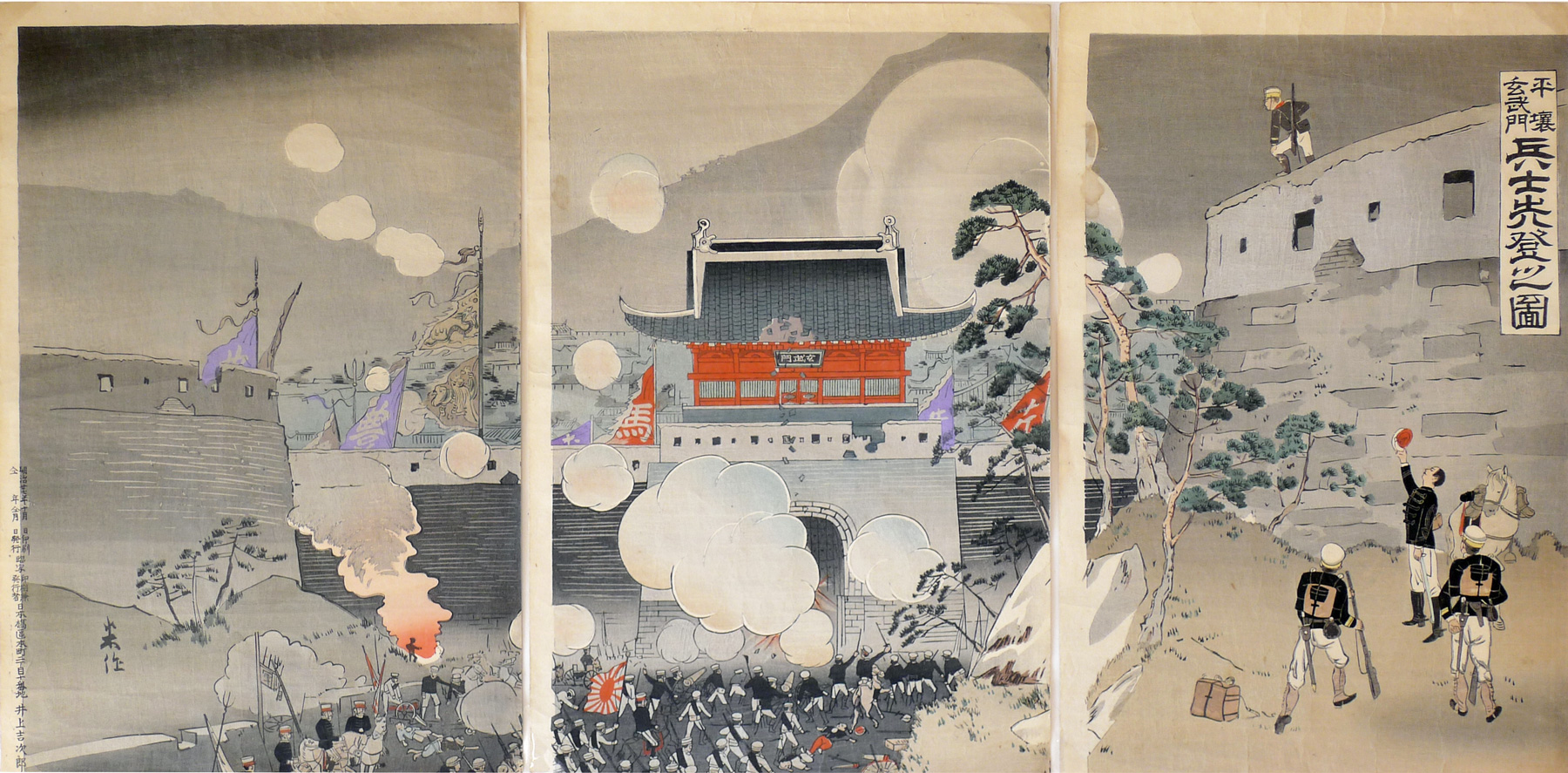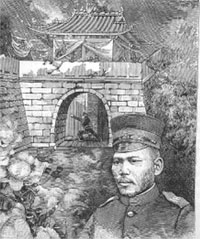About This Print
The top of the right sheet of this triptych, likely depicts Harada Jukichi on top of the Genbu Gate fort. For another print depicting Harada see IHL Cat. #93 Harada Jukichi Opens the Genbu Gate from Within the Fort at Pyongyang.Saga of Harada Jukichi
Source: Impressions of the Front: Woodcuts of the Sino-Japanese War, Shunpei Okamoto, Philadelphia Museum of Art, 1983, p. 24Pingyang (Pyongyang) was well protected by walls that had to be surmounted in order to conquer the city. Repeated frontal attacks by the Japanese failed to penetrate, even after exhausting all their ammunition. One volunteer in the Eighteenth Regiment, twenty-seven year-old Harada Jukichi of Aichi prefecture, a mild man with a wife and a daughter, saw his regiment fail three times to penetrate the fortification and fearlessly scaled the wall of Gembu Gate. Harada lowered himself into the midst of the enemy and opened the gate from within. His comrades them flooded into the enemy fort. Harada's action was considered so meritorious that he was immediately promoted to the rank of superior private. Harada's deed was widely celebrated in poems and prose. A particularly famous song includes this verse:
Diving under bullets thicker than rain,
he scrabbles up the castle wall,
like a monkey and lightly jumps inside;
this man is none other than Mr. Harada Jukichi
following him, platoon commander Mimura
Harada received the Order of the Golden Kite for his feat, but his honor proved overwhelming. He began a life of drunken dissipation and later was employed in the theater district reenacting his deed of heroism at Gembu Gate. The military authorities are said to have rebuked him for soiling the honor of the imperial army. It is also said that the soldier who actually climbed the gate first was Matsumura Aktaro, not Harada. Since Harada had already been decorated, this embarrassing fact was silenced. Matsumura was intimidated by the authorities and did not disclose the incident but secluded himself in his father's antique shop seeking truth among the collection of antiques.
Print Details
| IHL Catalog | #845 |
| Title or Description | Illustration of the First Soldier on Top of Pyongyang (Hyonmu) Gate in Pyongyang (平壌玄武門兵士先登之圖 Heijō Genbumon heishi sentō no zu) |
| Artist | Taguchi Beisaku (1864-1903) |
| Signature |  |
| Seal | none |
| Publication Date | October 1894 明治廿七年十月 |
| Publisher |  |
| Impression | excellent |
| Colors | excellent |
| Condition | good- full-size and unbacked; extensive wrinkling; light toning; several stains |
| Genre | ukiyo-e - senso-e (Sino-Japanese War) |
| Miscellaneous | |
| Format | vertical oban triptych |
| H x W Paper | 14 1/2 x 9 7/8 in. (36.8 x 25.1 cm) each sheet |
| Literature | Impressions of the Front: Woodcuts of the Sino-Japanese War, Okamoto, Shumpei, Philadelphia Museum of Art, 1983, p. 24, pl. 18; The Sino-JapaneseWar, Nathan Chaikin, self-published, 1983, p. 74., pl. 40. |
| Collections This Print | Museum of Fine Arts, Boston: Jean S. and Frederic A. Sharf Collection 2000.193a-c; Philadelphia Museum of Art 1976-75-3; Waseda University Library チ05 03893 0006; National Diet Library 8-5-1-2 04-19, 20, 21; British Library shelfmark: 16126.d.2(82) and 16126.d.3(20) |
4/8/2021
3/20/2020



